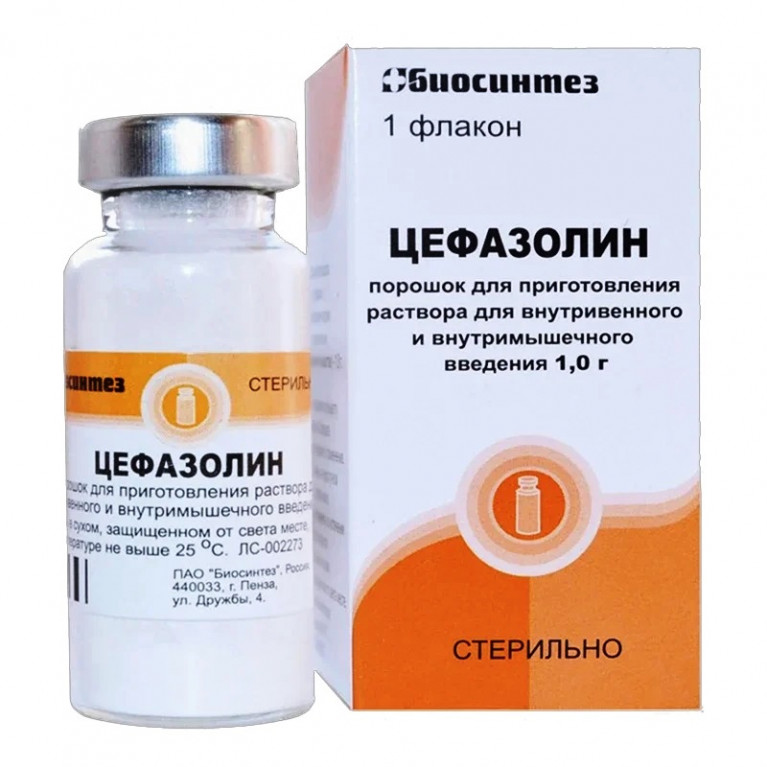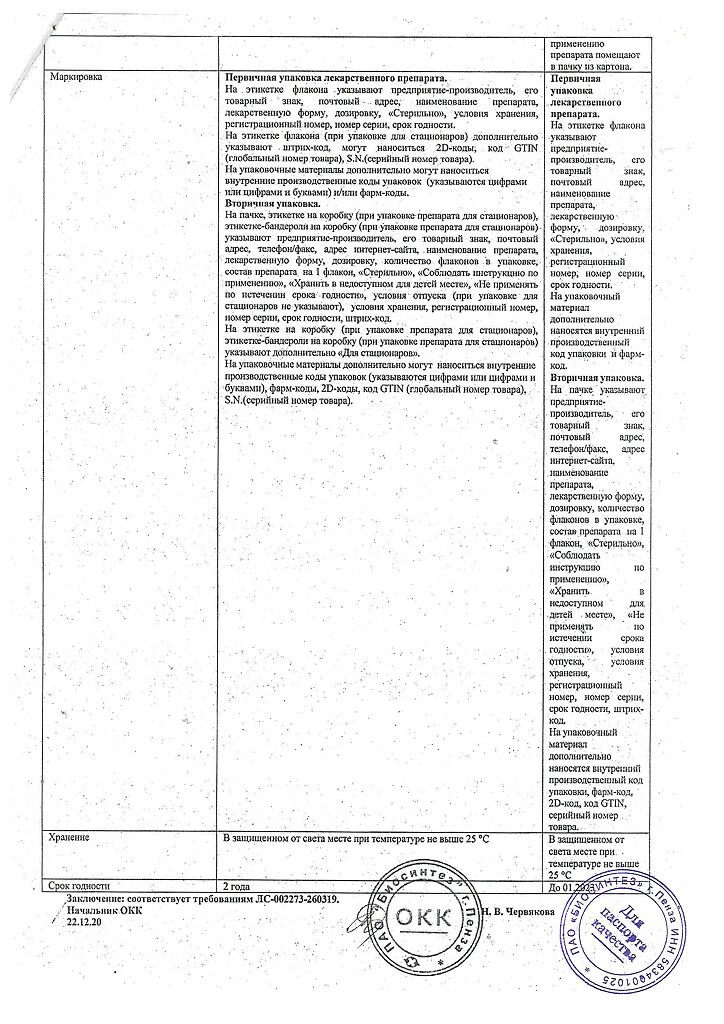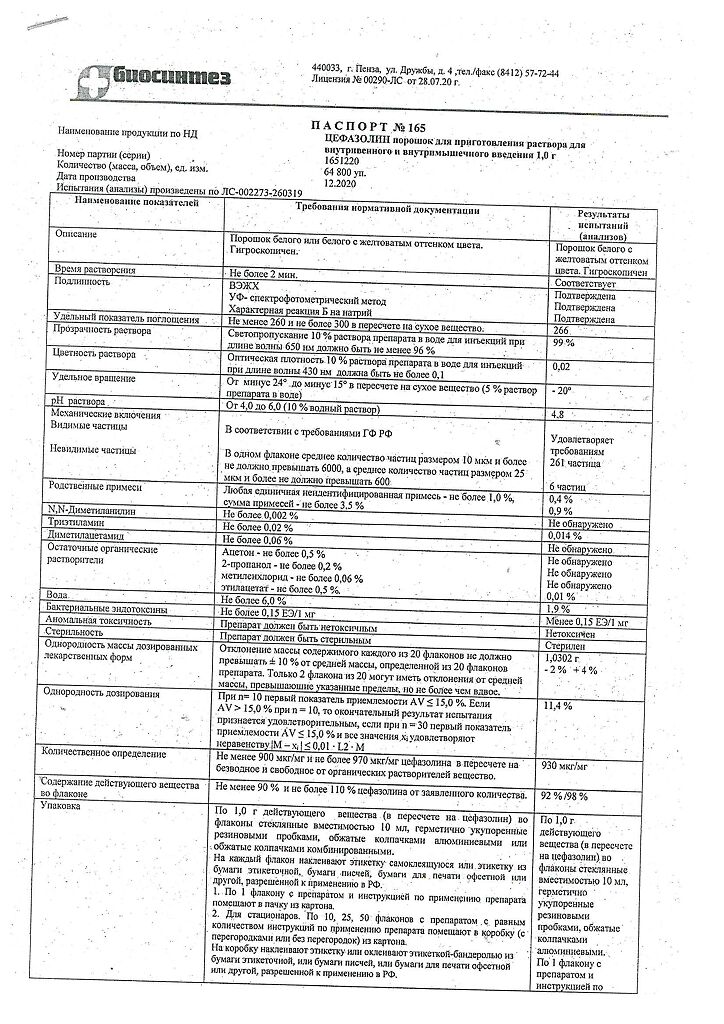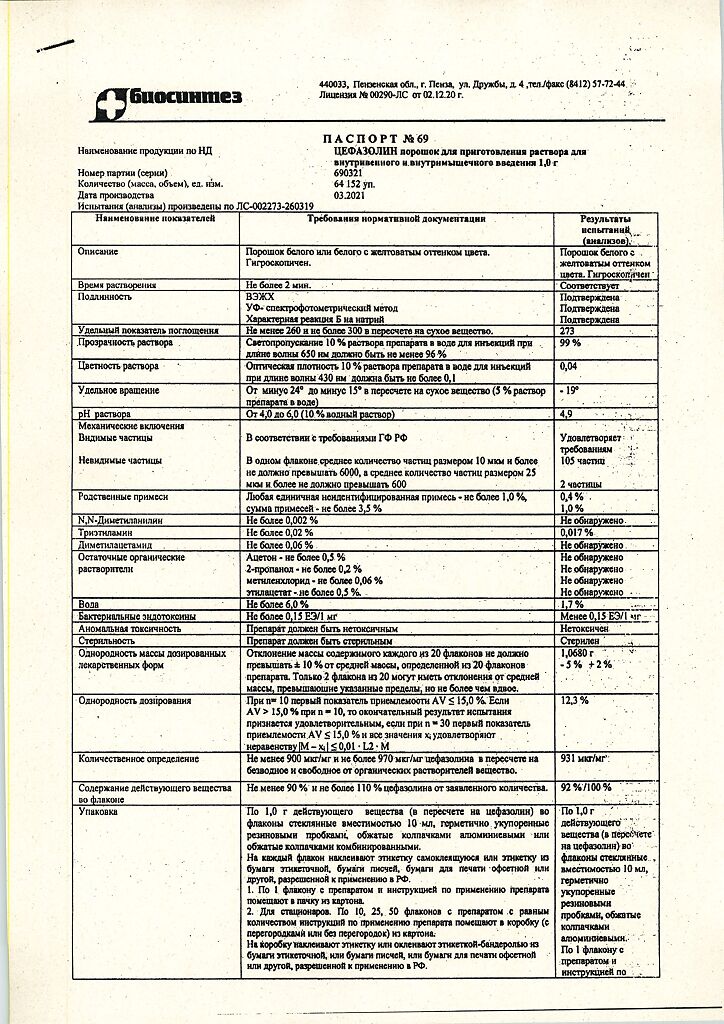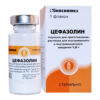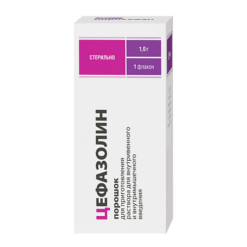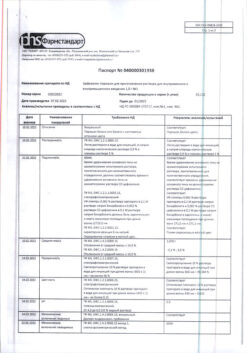No products in the cart.
Description
Pharmacotherapeutic group: Antibiotic of cephalosporin group
ATC code: J01DB04
Pharmacodynamics
Semi-synthetic cephalosporin antibiotic of the first generation for parenteral use. It acts bactericidally by blocking penicillin-binding proteins (e.g., transpeptidases), disrupts cell wall synthesis of microorganisms. It has a wide spectrum of action. The prevalence of acquired resistance may vary geographically and also change over time, local information should be considered, especially in the case of treatment of severe infections.
Microorganisms susceptible to cefazolin
Gram-positive aerobes: Staphylococcus aureus (sensitive to methicillin), Staphylococcus saprophyticus, Streptococcus pneumoniae, Streptococcus agalactiae, Streptococcus pyogenes, Corynebacterium diphtheria, Bacillus anthracis.
Gram-negative microorganisms: Neisseria meningitidis, Neisseria gonorrhoeae, Shigella spp., Salmonella spp., Treponema spp., Leptospira spp.
Microorganisms moderately sensitive to cefazolin
Gram-positive aerobes: Staphylococcus aureus, Staphylococcus epidermidis*, Staphylococcus haemolyticus*, Staphylococcus hominis*, Steptococcus pneumoniae* (moderately sensitive to penicillins);
Gram-negative aerobes: Escherichia coli, Haemophilus influenzae**, Klebsiella oxytoca***, Klebsiella pneumoniae, Proteus mirabilis.
Microorganisms with natural resistance to cefazolin
Gram-positive aerobes: Enterococcus spp., Staphylococcus aureus (resistant to methicillin), Staphylococcus pneumoniae (resistant to penicillin).
Gram-negative aerobes: Acinetobacter baumanii, Citrobacter freundii, Enterobacter spp.; Morganella morganii, Moraxella catarrhalis, Proteus vulgaris, Pseudomonas aeruginosa, Serratia marcescens, Stenotrophomonas maltophilia.
Anaerobes: Bacteroides fragilis.
Other microorganisms: Chlamydia spp., Chlamydophila spp., Legionella spp., Mycoplasma spp.
Penicillin-resistant Streptococcus pneumoniae, due to the presence of cross-resistance to cephalosporins, are insensitive to cephalosporins, including cefazolin.
* In some regions, the rate of microbial resistance may exceed 50%;
** current data on the prevalence of resistance are not available, studies (more than 5 years old) have reported a rate of microbial resistance of >50%.
Pharmacokinetics
Intake
Cefazolin is not absorbed when taken orally, so it is only used parenterally. After intramuscular (i.m.) injection, cefazolin is quickly absorbed from the injection site. Compared with most other cephalosporins, the concentration of cefazolin in blood plasma is higher and lasts longer.
Distribution
The binding of cefazolin to plasma proteins is 70-90%. Cefazolin penetrates well into various organs and tissues, including lungs, liver, skin and soft tissues, joints, heart, peritoneum, middle ear, tonsils, gallbladder wall, appendix, as well as into bodily fluids. Very high concentrations of the drug are created in the kidneys – after administration of 1 g of cefazolin its concentration in the urine reaches 4000 mcg/ml.
In absence of biliary obstruction, 90-120 minutes after administration of the drug, cefazolin is found in bile at higher concentration than in blood plasma. It should be taken into account that in patients with impaired patency of the biliary tract, concentration of the drug in bile may be significantly lower than the plasma concentration.
The drug penetrates through the placental barrier and is detected in breast milk. It penetrates into the cerebrospinal fluid (CSF) in small amounts; against the background of inflammation of the dura mater the concentration of the drug in the CSF is 0-0.4 µg/ml.
Cefazolin passes through capillary membranes in bone and reaches bactericidal concentrations in both healthy and affected bones with osteomyelitis. The concentration of cefazolin in joint fluid is comparable with that in blood plasma. In therapeutic concentrations it is found in ascitic and pleural fluid, inflammatory exudate.
Metabolism
Cefazolin is not metabolized in humans.
Elimation
Most of the administered cefazolin is excreted by the kidneys through glomerular filtration and tubular secretion in a microbiologically active form. During the first 6 hours after administration the kidneys excrete 60-90% of cefazolin, during the day – 70-95% of the administered dose. A small part of cefazolin is excreted with bile.
Half-life period in patients with impaired renal function may be prolonged up to 20-40 hours.
Indications
Indications
Bacterial infections caused by microorganisms sensitive to cefazolin:
– respiratory tract infections;
– urinary and genital tract infections;
– biliary tract infections;
– infections of the skin, soft tissues, bones and joints,
– bacterial endocarditis, sepsis;
– intraoperative prevention of infections (prophylactic use of cefazolin can reduce the likelihood of developing infections in the postoperative period).
Antibiotic susceptibility in vitro varies across geographic regions and over time, so local resistance information must be taken into account when choosing antibiotic therapy. If possible, the sensitivity of the pathogen to antibacterial drugs should be determined. Therapy can be started empirically, pending the results of an antibiotic susceptibility test.
Pharmacological effect
Pharmacological effect
Pharmacotherapeutic group: Antibiotic of the cephalosporin group
ATX code: J01DB04
Pharmacodynamics
Cephalosporin semisynthetic antibiotic of the first generation for parenteral use. It acts bactericidal, blocking penicillin-binding proteins (for example, transpeptidases), disrupts the synthesis of the cell wall of microorganisms. Has a wide spectrum of action. The prevalence of acquired resistance may vary geographically and may also change over time, and local information should be taken into account, especially when treating severe infections.
Microorganisms sensitive to cefazolin
Gram-positive aerobes: Staphylococcus aureus (sensitive to methicillin), Staphylococcus saprophyticus, Streptococcus pneumoniae, Streptococcus agalactiae, Streptococcus pyogenes, Corynebacterium diphtheria, Bacillus anthracis.
Gram-negative microorganisms: Neisseria meningitidis, Neisseria gonorrhoeae, Shigella spp., Salmonella spp., Treponema spp., Leptospira spp.
Microorganisms moderately sensitive to cefazolin
Gram-positive aerobes: Staphylococcus aureus, Staphylococcus epidermidis*, Staphylococcus haemolyticus*, Staphylococcus hominis*, Steptococcus pneumoniae* (moderately sensitive to penicillins);
Gram-negative aerobes: Escherichia coli, Haemophilus influenzae**, Klebsiella oxytoca***, Klebsiella pneumoniae, Proteus mirabilis.
Microorganisms that are naturally resistant to cefazolin
Gram-positive aerobes: Enterococcus spp., Staphylococcus aureus (resistant to methicillin), Staphylococcus pneumoniae (resistant to penicillin).
Gram-negative aerobes: Acinetobacter baumanii, Citrobacter freundii, Enterobacter spp.; Morganella morganii, Moraxella catarrhalis, Proteus vulgaris, Pseudomonas aeruginosa, Serratia marcescens, Stenotrophomonas maltophilia.
Anaerobes: Bacteroides fragilis.
Other microorganisms: Chlamydia spp., Chlamydophila spp., Legionella spp., Mycoplasma spp.
Penicillin-resistant Streptococcus pneumoniae, due to the presence of cross-resistance to cephalosporins, is insensitive to cephalosporins, including cefazolin.
* in some regions the frequency of resistance of microorganisms may exceed 50%;
** There are no current data on the prevalence of resistance; studies (more than 5 years old) reported a resistance rate of microorganisms >50%.
Pharmacokinetics
Suction
When taken orally, cefazolin is not absorbed, so it is used only parenterally. After intramuscular (IM) administration, cefazolin is rapidly absorbed from the injection site. Compared to most other cephalosporins, the plasma concentration of cefazolin is higher and lasts longer.
Distribution
The binding of cefazolin to plasma proteins is 70–90%. Cefazolin penetrates well into various organs and tissues, including the lungs, liver, skin and soft tissues, joints, heart, peritoneum, middle ear, tonsils, gallbladder wall, appendix, as well as into physiological body fluids. Very high concentrations of the drug are created in the kidneys – after administration of 1 g of cefazolin, its concentration in the urine reaches 4000 mcg/ml.
In the absence of biliary obstruction, 90–120 minutes after drug administration, cefazolin is found in bile in higher concentrations than in blood plasma. It should be taken into account that in patients with obstructed bile ducts, the concentration of the drug in the bile may be significantly lower than the plasma concentration.
The drug penetrates the placental barrier and is found in breast milk. Penetrates into the cerebrospinal fluid (CSF) in small quantities; against the background of inflammation of the pia mater, the concentration of the drug in the CSF is 0–0.4 mcg/ml.
Cefazolin passes through capillary membranes in bones and reaches bactericidal concentrations in both healthy and osteomyelitis-affected bones. The concentration of cefazolin in joint fluid is comparable to the concentration in blood plasma. In therapeutic concentrations it is found in ascitic and pleural fluids, inflammatory exudate.
Metabolism
Cefazolin is not metabolized in the human body.
Removal
Most of the administered cefazolin is excreted by the kidneys due to glomerular filtration and tubular secretion in a microbiologically active form. During the first 6 hours from the moment of administration, 60-90% of cefazolin is excreted by the kidneys, and within 24 hours – 70-95% of the administered dose. A small part of cefazolin is excreted from the body along with bile.
The half-life in patients with impaired renal function may be prolonged to 20–40 hours.
Special instructions
Special instructions
Hypersensitivity reactions
Before starting the use of cefazolin, the patient’s allergy history should be collected due to the possibility of cross-hypersensitivity between cephalosporins and other beta-lactam antibiotics. During therapy with cefazolin, the development of severe, including fatal, allergic reactions has been described. In the event of a severe hypersensitivity reaction, discontinuation of cefazolin and administration of appropriate symptomatic therapy is necessary. The drug is contraindicated in patients with a history of severe hypersensitivity reactions to cephalosporins or any other beta-lactam antibiotics.
Particularly careful monitoring of patients with a tendency to allergic reactions (allergic rhinitis, bronchial asthma) is necessary, since the presence of such conditions increases the risk of hypersensitivity reactions.
Diarrhea associated with the use of antibacterial drugs
The development of severe and persistent diarrhea during treatment and in the first weeks after completion of therapy may be a manifestation of pseudomembranous colitis caused by Clostridium difficile. Since this condition is life-threatening, cefazolin should be immediately discontinued and specific antibacterial therapy (for example, vancomycin or metronidazole) should be prescribed. Symptomatic maintenance therapy is indicated, including correction of water and electrolyte balance and nutritional disorders. The use of drugs that inhibit intestinal motility is contraindicated. In particularly severe cases, when the infection is resistant to antibiotic therapy, a colectomy may be required. Particular attention should be paid to carefully collecting the patient’s medical history, as cases of the development of pseudomembranous colitis have been described within two months from the date of antibacterial therapy.
Renal dysfunction
Due to the accumulation of the drug in the body, in patients with reduced renal function, the dose of the drug should be adjusted according to the severity of renal failure (see also section “Method of administration and dosage”). Although the use of cefazolin rarely causes renal dysfunction and the development of renal failure, it is recommended to evaluate renal function during the use of the drug, especially in patients who are in serious condition when using high doses of the drug and/or other nephrotoxic drugs (for example, aminoglycosides, loop diuretics).
Development of bacterial resistance and superinfections
Long-term use of cefazolin can provoke the emergence of resistant strains of bacteria. Patients should be carefully monitored for the possibility of superinfection and appropriate measures should be taken if it develops.
Reduced blood clotting and bleeding
In rare cases, the use of cefazolin may reduce blood clotting. Risk factors include vitamin K deficiency, parenteral nutrition, nutritional deficiency, renal and/or hepatic impairment, thrombocytopenia, and anticoagulant therapy. In addition, diseases such as hemophilia, ulceration of the mucous membrane of the stomach and/or duodenum can cause the development or intensification of bleeding. Therefore, it is necessary to monitor coagulation parameters in patients with known presence of these diseases. If a decrease in blood clotting is detected, vitamin K therapy (10 mg/week) should be prescribed.
Use of the drug in children
Cefazolin should not be prescribed to premature and newborn infants within 1 month of life, since to date there is no data demonstrating the safety of its use in this patient population.
Sodium content
1 g of cefazolin contains approximately 48 mg of sodium, which should be taken into account when using the drug in patients on a diet that limits sodium intake.
Effect on laboratory parameters
During the use of cefazolin, false-positive reactions in determining the concentration of glucose in urine are possible when using Benedict’s or Fehling’s reagent, as well as false-positive results of the direct and indirect Coombs test.
With long-term use of the drug, monitoring of the peripheral blood picture is necessary.
Taking ethanol during treatment
Due to the possibility of developing disulfiram-like reactions with the use of cefazolin, patients should refrain from drinking alcohol during the treatment period.
Intrathecal administration
Cefazolin should not be administered intrathecally due to the possibility of severe toxic damage to the central nervous system (including the development of seizures).
Impact on the ability to drive vehicles and machinery
No effect of cefazolin on the ability to drive vehicles or operate machinery was detected. However, since the use of cefazolin may cause the development of side effects such as nausea, vomiting, dizziness and convulsions, caution should be exercised when performing these activities and refrain from them if these adverse events develop.
Active ingredient
Active ingredient
Cefazolin
Composition
Composition
Active ingredient:
Cefazolin sodium in terms of cefazolin – 1.0 g
Pregnancy
Pregnancy
Pregnancy
Cefazolin crosses the placenta. Preclinical studies of cefazolin in animals did not show the presence of direct or indirect reproductive toxicity. However, since there is insufficient data on the safety of cefazolin, the use of cefazolin during pregnancy is permissible only if the expected benefit to the mother outweighs the potential risk to the fetus.
Breastfeeding period
Cefazolin passes into breast milk in extremely small quantities; when cefazolin is used in therapeutic doses, exposure to a newborn baby is unlikely. If a breastfed newborn develops diarrhea or symptoms of candidiasis, consideration should be given to stopping breastfeeding or discontinuing the drug.
Contraindications
Contraindications
– hypersensitivity to cefazolin;
– a history of severe hypersensitivity reactions (for example, anaphylactoid reactions) to cephalosporins or any other beta-lactam antibiotics (penicillins, monobactams, carbapenems);
– neonatal period up to 1 month, including premature babies.
When using lidocaine solution as a solvent, see instructions for use of lidocaine.
With caution
– concomitant use of other nephrotoxic drugs;
– history of mild hypersensitivity reactions to penicillins;
– chronic renal failure;
– intestinal diseases (including a history of colitis);
– children’s age from 1 to 12 months.
Side Effects
Side Effects
In accordance with the classification of the World Health Organization (WHO), adverse reactions are presented according to the frequency of their development: very often (>1/10); often (>1/100, 1/1000, 1/10000, <1/1000) and very rarely (<1/10000), frequency unknown - it was not possible to determine the frequency of occurrence based on available data.
Infections and parasitic infestations
Uncommon: oral candidiasis (with long-term use);
Rarely: genital candidiasis, vaginitis.
Blood and lymphatic system disorders
Rarely: leukopenia, granulocytopenia, neutropenia, thrombocytopenia, leukocytosis, granulocytosis, monocytosis, lymphocytosis, thrombocytosis, lymphocytopenia, basophilia, eosinophilia. As a rule, these adverse events are short-term and reversible;
Very rare: bleeding disorders and, as a result, increased bleeding, anemia, agranulocytosis, aplastic anemia, pancytopenia, hemolytic anemia.
Immune system disorders
Uncommon: fever, arthralgia;
Very rare: anaphylactic shock (development of laryngeal edema with narrowing of the airway, increased heart rate, shortness of breath, decreased blood pressure, swelling of the tongue, swelling of the face, anal and/or genital itching).
Metabolic and nutritional disorders
Rarely: hyperglycemia or hypoglycemia.
Nervous system disorders
Uncommon: development of seizures (in patients with impaired renal function when using the drug in high doses if the dosage regimen is not followed);
Rarely: dizziness, malaise, general weakness, nightmares, vertigo, hyperactivity, nervousness or anxiety, insomnia or drowsiness, impaired color vision, confusion, increased convulsive activity of the brain.
Vascular disorders
Rarely: hot flashes.
Respiratory, thoracic and mediastinal disorders
Rarely: pleural effusion, chest pain, bronchospasm, shortness of breath, cough, development of acute respiratory distress syndrome, rhinitis.
Gastrointestinal disorders
Common: loss of appetite, diarrhea, nausea, vomiting, abdominal pain.
Very rare: development of pseudomembranous colitis. This condition requires immediate initiation of treatment (see also distributed “Special Instructions”).
Disorders of the liver and biliary tract
Rarely: transient increase in the activity of “liver” transaminases: alanine aminotransferase (ALT), aspartate aminotransferase (AST), alkaline phosphatase, gamma-glutamyltransferase, lactate dehydrogenase, increased concentration of bilirubin in the blood plasma, transient hepatitis, cholestatic jaundice.
Skin and subcutaneous tissue disorders
Common: rash;
Uncommon: erythema, exudative (polymorphic) erythema, urticaria, pruritus, angioedema (Quincke’s edema);
Rare: toxic epidermal necrolysis (Lyell’s syndrome), erythema malignant exudative (Stevens-Johnson syndrome).
Renal and urinary tract disorders
Rarely: interstitial nephritis, proteinuria, transient increase in plasma urea concentration (usually in patients receiving therapy in combination with other nephrotoxic drugs), unspecified nephropathy and other manifestations of nephrotoxicity.
Influence on the results of laboratory and instrumental studies
Frequency unknown: false-positive Coombs test, hypercreatininemia, increased prothrombin time, false-positive urine test for glucose.
General disorders and reactions at the injection site
Often: pain at the injection site after intramuscular injection, sometimes with the development of compaction;
Uncommon: thrombophlebitis and phlebitis – with intravenous administration.
Interaction
Interaction
Cefazolin can reduce the effectiveness of oral contraceptives. For this reason, additional contraceptive measures should be used during treatment with the drug.
Cefazolin should not be used in conjunction with other antibacterial drugs that have a bacteriostatic effect (for example, tetracyclines, sulfonamides, erythromycin, chloramphenicol), since in vitro studies have revealed antagonism between these drugs.
When used together with cefazolin, it is possible to enhance the nephrotoxic properties of other antibacterial drugs (for example, aminoglycosides, colistin, polymyxin B); iodine-containing contrast agents; high doses of methotrexate; some antiviral drugs (eg, acyclovir, foscarnet); pentamidine; cyclosporine; tacrolimus; platinum-containing drugs and diuretics (for example, furosemide). If it is necessary to use them together with cefazolin, renal function should be carefully monitored.
When used simultaneously with loop diuretics (for example, furosemide), the tubular secretion of cefazolin is blocked, which leads to an increase in its concentration in the blood plasma. For this reason, the combined use of these drugs should be avoided.
When cefazolin and probenecid are used together, the renal clearance of cefazolin is reduced, which leads to an increase in the elimination time of cefazolin and an increase in its plasma concentration.
In rare cases, cephalosporins can cause bleeding disorders. If combined use with oral anticoagulants is necessary, especially in high doses, coagulogram parameters should be monitored.
Some cephalosporin antibiotics, for example, cefamandole, cefotetan and cefazolin, by suppressing intestinal microflora, can disrupt the metabolism of vitamin K, which reduces its formation in the body, especially in patients with an initial deficiency. Vitamin K supplements may be required. When used concomitantly with drugs that reduce platelet aggregation (for example, non-steroidal anti-inflammatory drugs), the risk of bleeding increases.
Cefazolin may cause disulfiram-like reactions when used concomitantly with ethanol.
Cefazolin is pharmaceutically incompatible with aminoglycoside antibiotics (gentamicin, kanamycin, amikacin, etc.); tetracyclines (oxytetracycline, tetracycline, etc.); colistimethate sodium; polymyxin B; erythromycin (in the form of glucoheptonate salt); barbituric derivatives (amobarbital, pentobarbital); bleomycin; calcium salts (calcium glucoheptonate, calcium gluconate); cimetidine; ascorbic acid.
Overdose
Overdose
Symptoms
Headache, vertigo, paresthesia, agitation, myoclonus, convulsions.
Laboratory signs: increased concentrations of creatinine and urea in the blood plasma, increased activity of “liver” transaminases and bilirubin concentrations, positive Coombs test, thrombocytopenia or thrombocytosis, eosinophilia, leukopenia and increased prothrombin time.
Treatment
If seizures develop, cefazolin should be immediately discontinued, vital signs should be carefully monitored, and symptomatic therapy should be provided if necessary; if seizures develop, anticonvulsants may need to be prescribed. In case of severe overdose and ineffectiveness of other treatment methods, hemodialysis may be performed. Peritoneal dialysis is not effective.
Storage conditions
Storage conditions
Store in a dry place, protected from light, at a temperature not exceeding 25°C.
Shelf life
Shelf life
2 years.
Manufacturer
Manufacturer
Biosynthesis, Russia
Additional information
| Shelf life | 2 years. |
|---|---|
| Conditions of storage | Store in a dry place, protected from light, at a temperature not exceeding 25 ° C. |
| Manufacturer | Biosintez, Russia |
| Medication form | Powder for preparation of solution |
| Brand | Biosintez |
Other forms…
Related products
Buy Cefazolin, 1 g with delivery to USA, UK, Europe and over 120 other countries.

